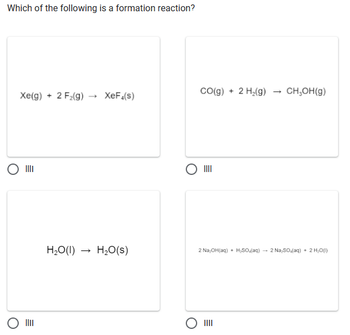
Chemistry
10th Edition
ISBN: 9781305957404
Author: Steven S. Zumdahl, Susan A. Zumdahl, Donald J. DeCoste
Publisher: Cengage Learning
expand_more
expand_more
format_list_bulleted
Concept explainers
Question

Transcribed Image Text:Which of the following is a formation reaction?
Xe(g) + 2 F₂(g) XeF4(s)
H₂O(l) H₂O(s)
CO(g) + 2 H₂(g) CH₂OH(g)
2 Na₂OH(aq) + H₂SO₂(aq) → 2 Na₂SO (aq) + 2 H₂O(1)
Expert Solution
This question has been solved!
Explore an expertly crafted, step-by-step solution for a thorough understanding of key concepts.
Step by stepSolved in 4 steps

Knowledge Booster
Learn more about
Need a deep-dive on the concept behind this application? Look no further. Learn more about this topic, chemistry and related others by exploring similar questions and additional content below.Similar questions
- When 0.376 g of sodium metal is added to an excess of hydrochloric acid, 3910 J of heat are produced. What is the enthalpy of the reaction as written? 2 Na(s) + 2 HCI(aq) 2 NaCl(aq) + H,(g) Enthalpy of reaction: 478.35 kJ Incorrectarrow_forwardFor the chemical reaction H₂ (g) + F2 (g) →→ 2 HF (g) AH = -79.2 kJ/mol. What is the enthalpy for the reaction 3 H₂ (g) + 3 F2 (g) → 6 HF (g)arrow_forwardCalculate the amount of salt in a commercial cold-pack containing ammonium nitrate (ΔHsol = + 25.7 kJ/mol) if the final temperature of the cold-pack is 3ºC. Assume that the initial temperature of water is 25ºC, mass of solution is 25 g and the specific heat of the solution is 4.184 J/g.K.arrow_forward
- Iron can be extracted from the iron(III) oxide found in iron ores (such as haematite) via an oxidation-reduction reaction with carbon. The thermochemical equation for this process is: 2 Fe203(s) + 3 C(s) → 4 Fe(1) + 3 CO2(g) AH° = +467.9 kJarrow_forwardThe reaction below is a exothermic or endothermic reaction. 2SO3(g) + Heat ⇋ 2SO2(g) + O2(g)arrow_forward4. When 1.00 L of 1.05 M Ba(NO3)2 solution is mixed with 1.00 L of 1.10 M NazSO4 solution at 25.0°C in a coffee-cup calorimeter. The reaction is Ba(NOs)2(aq) + NazSO4(aq) → BaSO4(s) + 2NANO:(aq). The final temperature of the mixture increases to 28.1°C. Calculate the enthalpy change per mole for this process. (Assuming C=4.18 J °C' g' and density of the final solution is 1.05 g/ml).arrow_forward
- Using the equations H₂ (g) + Cl₂ (g) → 2 HCI (g) AH° = -184.6 kJ/mol C (s) + 2 Cl₂ (g) →→ CCI (g) AH° = -95.7 kJ/mol Determine the molar enthalpy (in kJ/mol) for the reaction C (s) + 4 HCI (g) → CCI (g) + 2 H₂ (g). 4 2arrow_forwardThe sugar arabinose, C5 H10 O5, is burned completely in oxygen in a calorimeter. C5 H10 O5 (8) + 502(g) → 5CO2(g) + 5H2 O(1) Burning a 0.541 g sample caused the temperature to rise from 20.00°C to 20.54°C. The heat capacity of the calorimeter and its contents is 15.2 kJ/°C. Calculate AH for the combustion reaction per mole of arabinose. ΔΗ+ kJ/molarrow_forwardIn the following equation for a chemical reaction, the notation (s), (1), or (g) indicates whether the substance indicated is in the solid, liquid, or gaseous state. 2NO(g) + 2H2(g) →N2(g) + 2H,O(M) + energy Identify each of the following as a product or a reactant: H2O)| NO(g) N2(g) H2(g) When the reaction takes place energy is The reaction isarrow_forward
- what is the enthalpy of this equationarrow_forwardWhich of the reactions are exothermic?arrow_forwardAmmonia reacts with oxygen according to the equation: 4NH3(g)+5O2(g)→4NO(g)+6H2O(g),ΔHrxn=−906 kJ. Calculate the heat (in kJ) associated with the complete reaction of 155 g of NH3 Express the heat in kilojoules to three significant figures.arrow_forward
arrow_back_ios
SEE MORE QUESTIONS
arrow_forward_ios
Recommended textbooks for you
 ChemistryChemistryISBN:9781305957404Author:Steven S. Zumdahl, Susan A. Zumdahl, Donald J. DeCostePublisher:Cengage Learning
ChemistryChemistryISBN:9781305957404Author:Steven S. Zumdahl, Susan A. Zumdahl, Donald J. DeCostePublisher:Cengage Learning ChemistryChemistryISBN:9781259911156Author:Raymond Chang Dr., Jason Overby ProfessorPublisher:McGraw-Hill Education
ChemistryChemistryISBN:9781259911156Author:Raymond Chang Dr., Jason Overby ProfessorPublisher:McGraw-Hill Education Principles of Instrumental AnalysisChemistryISBN:9781305577213Author:Douglas A. Skoog, F. James Holler, Stanley R. CrouchPublisher:Cengage Learning
Principles of Instrumental AnalysisChemistryISBN:9781305577213Author:Douglas A. Skoog, F. James Holler, Stanley R. CrouchPublisher:Cengage Learning Organic ChemistryChemistryISBN:9780078021558Author:Janice Gorzynski Smith Dr.Publisher:McGraw-Hill Education
Organic ChemistryChemistryISBN:9780078021558Author:Janice Gorzynski Smith Dr.Publisher:McGraw-Hill Education Chemistry: Principles and ReactionsChemistryISBN:9781305079373Author:William L. Masterton, Cecile N. HurleyPublisher:Cengage Learning
Chemistry: Principles and ReactionsChemistryISBN:9781305079373Author:William L. Masterton, Cecile N. HurleyPublisher:Cengage Learning Elementary Principles of Chemical Processes, Bind...ChemistryISBN:9781118431221Author:Richard M. Felder, Ronald W. Rousseau, Lisa G. BullardPublisher:WILEY
Elementary Principles of Chemical Processes, Bind...ChemistryISBN:9781118431221Author:Richard M. Felder, Ronald W. Rousseau, Lisa G. BullardPublisher:WILEY

Chemistry
Chemistry
ISBN:9781305957404
Author:Steven S. Zumdahl, Susan A. Zumdahl, Donald J. DeCoste
Publisher:Cengage Learning

Chemistry
Chemistry
ISBN:9781259911156
Author:Raymond Chang Dr., Jason Overby Professor
Publisher:McGraw-Hill Education

Principles of Instrumental Analysis
Chemistry
ISBN:9781305577213
Author:Douglas A. Skoog, F. James Holler, Stanley R. Crouch
Publisher:Cengage Learning

Organic Chemistry
Chemistry
ISBN:9780078021558
Author:Janice Gorzynski Smith Dr.
Publisher:McGraw-Hill Education

Chemistry: Principles and Reactions
Chemistry
ISBN:9781305079373
Author:William L. Masterton, Cecile N. Hurley
Publisher:Cengage Learning

Elementary Principles of Chemical Processes, Bind...
Chemistry
ISBN:9781118431221
Author:Richard M. Felder, Ronald W. Rousseau, Lisa G. Bullard
Publisher:WILEY